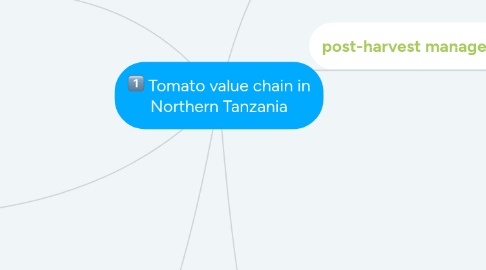
1. Research
1.1. Competitors
1.2. Customers needs
1.3. Supporting services
1.4. Marketing strategies
1.4.1. 4Ps
1.4.1.1. Customer needs
2. Value addition
2.1. Sorting
2.1.1. Market segments
2.2. Packaging
2.2.1. Expiry dates
2.2.2. Labeling
2.2.3. Recycling information
2.2.4. Ingredients information
2.2.5. Forms and types of packaging
2.2.5.1. Volume
3. Marketing
3.1. Marketing barriers
3.1.1. Poor transport and storage infrastructure
3.1.2. Lack of market information
3.1.2.1. Middlemen
3.1.3. Low supply
3.1.4. Poor market orientation
3.1.4.1. Leadership skills
3.1.5. Tarrifs
3.1.6. Poor coordination in the network
3.2. Distribustion
3.2.1. Wholesales
3.2.1.1. Retailers
3.2.1.1.1. Ultimate consumers
3.2.2. Retailers
3.2.2.1. Ultimate consumer
4. post-harvest management
4.1. Poor technologies
4.1.1. Mass losses
4.1.1.1. Low returns
4.2. Food insecurity
4.2.1. Income poverty
4.3. Value adding
4.3.1. Increase shelf life
4.3.1.1. Low loses
5. Production
5.1. Inputs
5.1.1. Production technologies
5.1.1.1. Improved ones
5.1.1.1.1. High yield
5.1.1.2. Traditional ones
5.1.1.2.1. Low yield
5.1.1.3. Government policies
5.1.1.3.1. Subsidies
5.1.2. Fertlizers
5.1.2.1. Organic
5.1.2.1.1. High product price
5.1.2.2. Inorganic
5.1.2.2.1. Low product prices
5.1.3. Seeds
5.1.3.1. Indigenous
5.1.3.2. Hybrids
5.1.3.2.1. adapted to climate change
5.2. Farmer producer groups
5.2.1. Meeting market demand
5.3. Climate change
5.3.1. More production costs
5.3.2. Late delivery of products
5.3.3. Low yield
5.3.4. Increase in pests and diseases

